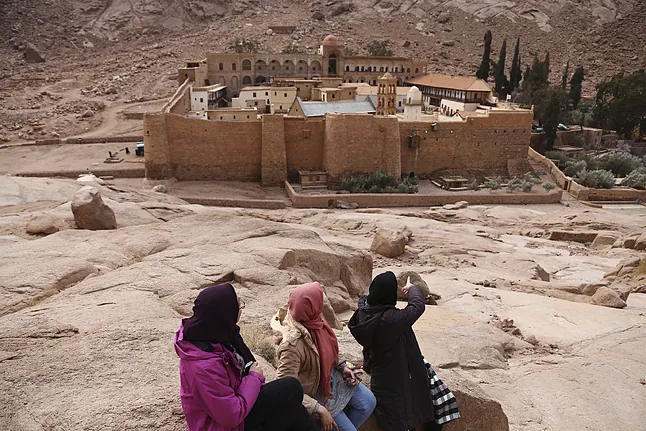A monastery inhabited since the 6th century, right where tradition places God speaking to Moses through a burning bush, has been facing off for a few days between two usual partners, Greece and Egypt. The monastery of Saint Catherine, located in the Sinai desert, is the oldest inhabited in the world and a UNESCO World Heritage Site. It is run by the Greek Orthodox Church, but a court ruled at the end of May that the lands belong to Egypt, a decision that has angered Athens, which has taken the matter as a state issue.
The Greek Minister of Foreign Affairs, Yorgos Gerapetritis, traveled to Cairo a few days ago to meet with Badr Abdelatty, his Egyptian counterpart, and, as both parties indicated, they agreed to safeguard the status of one of the oldest Christian places of worship in the world, which houses a library that, due to the value of its manuscripts, has been compared to that of the Vatican, in addition to important Byzantine-style icons and mosaics. The agreement seems to temporarily set aside a conflict that has caused much concern in Greece.
"We have agreed to work in the immediate future to safeguard the rights of the monastery, as well as its legal status," declared the Greek minister at the end of the meeting, stating that "both Egypt and Greece intend to move forward based on the long tradition and on the established status of a monastery emblematic for its Greek Orthodox worship character." On the other hand, the Egyptian representative stated that the ruling preserves "the deep spiritual value and the religious prestige of the monastery," confirming that the monks will be able to continue living there and accessing all historical sites.
In response, the monks have decided to close their doors tightly due to the uncertainty about the future of their monastery, a place of pilgrimage for believers from around the world despite the geopolitical uncertainties of the area (in 2017 there was an attack by the Islamic State, and it is about a five-hour drive from the Israeli border). According to Christian history researcher Souhail Lawand in an article for the Arabic Catholic news agency ACI MENA, "Athens fears that the decision may facilitate the transformation of the monastery from an active religious site to a museum for visiting tourists and pave the way for the possible eviction of the monks, as only the abbot, Archbishop Damianos, holds Egyptian citizenship."
Lawand recalls in his text the project 'The Great Transfiguration' launched by Egyptian President Al Sisi in 2021. The idea aimed to transform the area into a large tourist center, with hotels, restaurants, and various services, as a "gift from Egypt to the whole world and all religions". The judicial decision made Greece fear that the plan would regain momentum, although the Egyptian Foreign Minister reassured amid the crisis that it will not affect Saint Catherine in any way.
"Seeking mutual understanding"
"The current situation is unsettling," says Egyptologist, researcher, and professor at the Faculty of Theology of Vitoria and the European University of Rome, María Luz Mangado. Her first visit to the monastery of Saint Catherine was decades ago when she was still a student, to follow the Exodus route. She discovered "a wonderful place, perfectly integrated into the landscape," which she has revisited several times over the years. "I understand that Egypt is currently defending its heritage very well because there have been many abuses, although today there is a very different awareness," she explains, "but we must consider the history of this monastery, which has had a certain autonomy depending on the Orthodox Church and has always functioned well." In her view, "this is a step back, and we must seek mutual understanding".
As an expert, María Luz Mangado recalls that the first building in that place was promoted by what Christianity knows as Saint Helena, the mother of Emperor Constantine, who granted freedom of worship to Christianity in Rome. Justinian, the Eastern Roman Emperor, expanded the monastery, which grew over the centuries and became an important place for the Crusaders. European monarchs "favored it greatly," and Ferdinand the Catholic made significant donations. Monks from there traveled to the Iberian Peninsula during the Middle Ages to found monasteries.
"The library is splendid, world-class," continues this expert, who explains that there is still much to research within its walls. "There is a collection in different ancient languages, in Syriac or Hebrew, which is not fully studied, as well as codices. For example, the Sinaitic Codex - containing the oldest version of the Bible written in Greek - could provide some surprises in biblical studies and in the early church," she passionately recounts.
"It is also linked to Islam because Muhammad issued a document to protect this place, and a mosque was built," she adds, so it is an important enrichment for the monotheistic religions, Judaism, Islam, and Christianity. For her, it is a place of "understanding" that is "heritage for all." If the fears about Saint Catherine were confirmed, "it would be as if Italy decided to nationalize the Vatican," concludes this Egyptologist.
* Due to an error, it was stated in an initial version that Emperor Constantine made Christianity the official religion of Rome, when it was actually Theodosius. Constantine granted freedom of worship.
